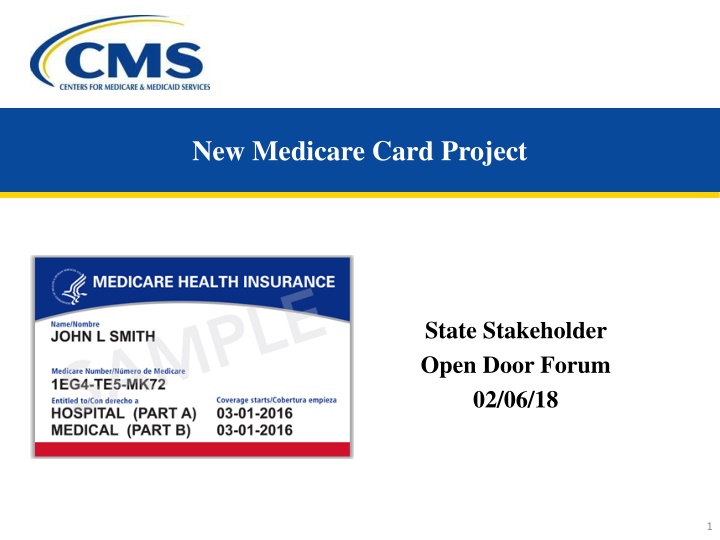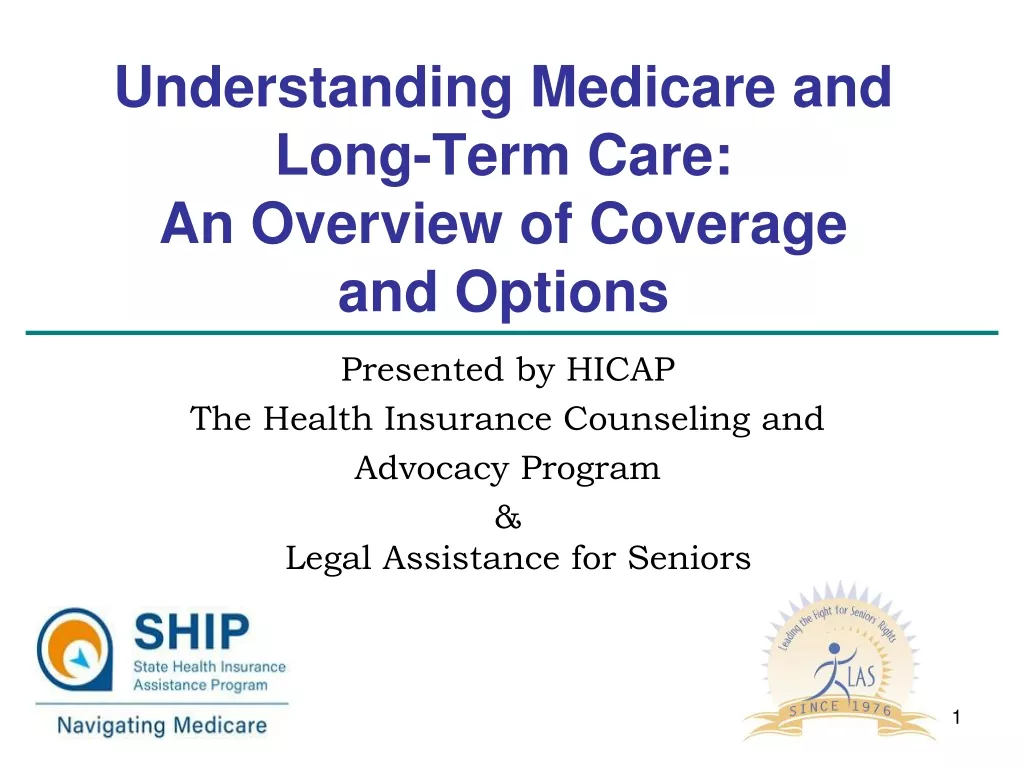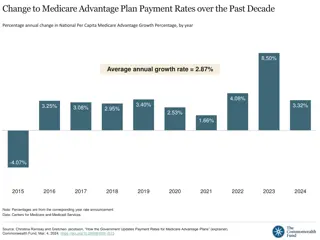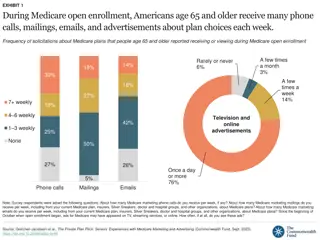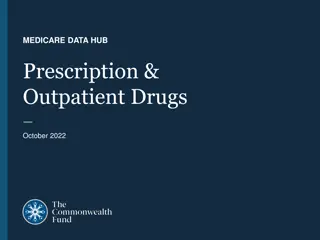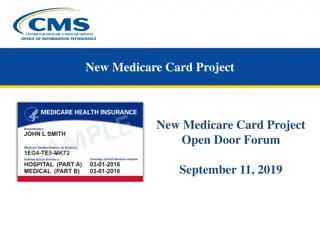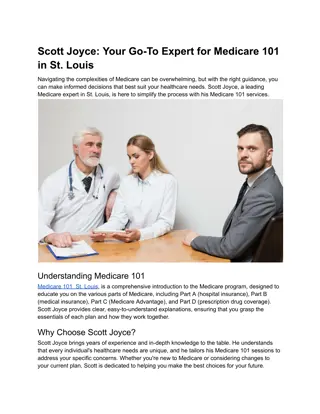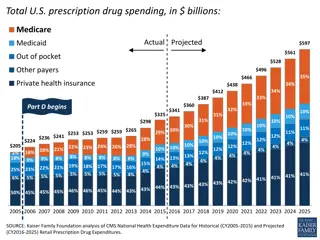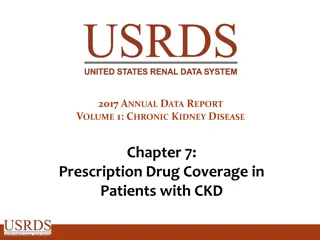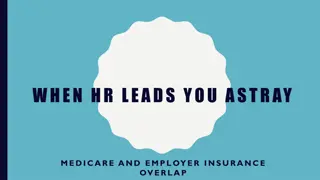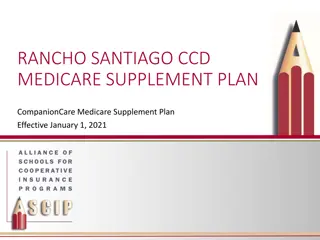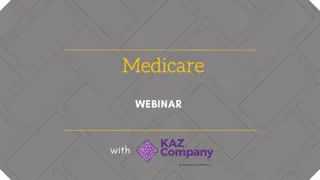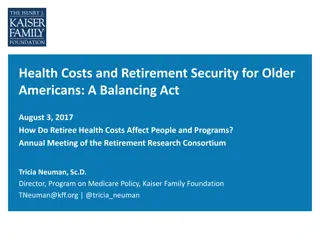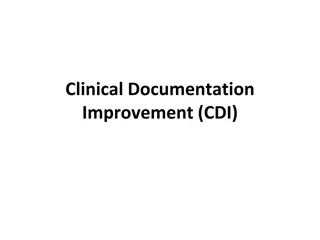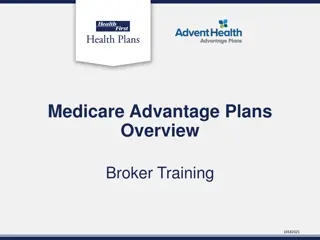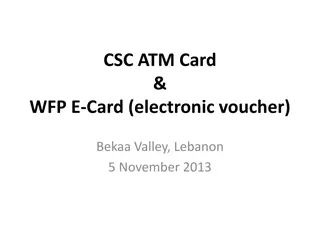New Medicare Card Project - Enhancing Identity Protection
The New Medicare Card Project aims to enhance identity protection by replacing SSN-based Medicare identification numbers with new unique Medicare Numbers. The project seeks to minimize burdens for beneficiaries and providers, reduce disruptions to Medicare operations, and provide secure data exchanges. With a focus on decreasing vulnerability to identity theft, the initiative involves complex system changes affecting various stakeholders, including federal partners, states, beneficiaries, providers, and plans. Close collaboration with state Medicaid agencies ensures successful implementation of the project.
Download Presentation

Please find below an Image/Link to download the presentation.
The content on the website is provided AS IS for your information and personal use only. It may not be sold, licensed, or shared on other websites without obtaining consent from the author.If you encounter any issues during the download, it is possible that the publisher has removed the file from their server.
You are allowed to download the files provided on this website for personal or commercial use, subject to the condition that they are used lawfully. All files are the property of their respective owners.
The content on the website is provided AS IS for your information and personal use only. It may not be sold, licensed, or shared on other websites without obtaining consent from the author.
E N D
Presentation Transcript
New Medicare Card Project State Stakeholder Open Door Forum 02/06/18 INFORMATION NOT RELEASABLE TO THE PUBLIC UNLESS AUTHORIZED BY LAW: This information has not been publicly disclosed and may be privileged and confidential. It is for internal government use only and must not be disseminated, distributed, or copied to persons not authorized to receive the information. Unauthorized disclosure may result in prosecution to the full extent of the law. 1
Background The Health Insurance Claim Number (HICN) is a Medicare beneficiary s identification number, used for processing claims and for determining eligibility for services across multiple entities (e.g., Social Security Administration (SSA), Railroad Retirement Board (RRB), States,Medicare providers, and health plans) The Medicare Access and CHIP Reauthorization Act (MACRA) of 2015 mandates the removal of the Social Security Number (SSN)-based HICN from Medicare cards to address current risk of beneficiary medicalidentity theft The legislation requires that CMS mail out new Medicare cards with a new Medicare Beneficiary Identifier (MBI) by April 2019 2 2
Operational Goals Primary Operational Goal: To decrease Medicare Beneficiary vulnerability to identity theft by removing the SSN-based number from their Medicare identification cards and replace with a new unique Medicare Number In achieving this goal CMS seeksto: Minimize burdens for beneficiaries Minimize burdens forproviders Minimize disruption to Medicareoperations Provide a solution to our business partners that allows usage of HICN and/or new Medicare Number for business critical dataexchanges Manage the cost, scope, and schedule for theproject 3
Complex IT Systems affecting Providers, Partners, and Beneficiaries Along with our partners, CMS will address complex systems changesfor over 75 systems, conduct extensive outreach & education activities and analyze the many changes that will be needed to systems and business processes Affected stakeholdersinclude: Federal partners, States, Beneficiaries, Providers, andPlans Other key stakeholders, such as billing agencies, advocacy groups,data warehouses,etc. CMS has been working closely with State Medicaid agencies, their partners and stakeholdersto implement the New Medicare Card Project 4
Implementation of New Medicare Numbers 5
Solution Concept for the New Medicare Cards The SSN Removal solution must provide the followingcapabilities: 1. Generate Medicare Beneficiary Identifiers (MBI) for all beneficiaries: Includes existing (currentlyactive, deceased, or archived) and new beneficiaries 2. Issue new, redesigned Medicare cards: New cards containing theMBI to existing and new beneficiaries 3. Modify systems and business processes: Required updatesto accommodate receipt, transmission, display, and processing of the MBI CMS will use an MBI generatorto: Assign 150 million MBIs in the initial enumeration (60 million active and90 million deceased/archived) and generate a unique MBI for each new Medicarebeneficiary Generate a new unique MBI for a Medicare beneficiary whose identityhas been compromised 6
HICN and MBI Number Health Insurance Claim Number(HICN) Primary Beneficiary Account Holder Social Security Number (SSN) plus Beneficiary Identification Code (BIC) 9-byte SSN plus 1 or 2-byteBIC Key positions 1-9 arenumeric Note: Identifiers are fictitious and dashes for display purposes only; they are not stored in the database nor used in file formats Medicare Beneficiary Identifier(MBI) New Non-Intelligent UniqueIdentifier 11bytes Key positions 2, 5, 8, and 9 will alwaysbe alphabetic 7
New Medicare Number Characteristics The Medicare Beneficiary Identifier (MBI) will have the following characteristics: The same number of characters as the current HICN (11), but will be visibly distinguishable from the HICN Contain uppercase alphabetic and numeric characters throughout the 11-digit identifier Occupy the same field as the HICN on transactions Be unique to each beneficiary (e.g., husband and wife will have their own MBI) Be easy to read and limit the possibility of letters being interpreted as numbers (e.g., alphabetic characters are upper case only and will exclude S, L, O, I, B, Z) Not contain any embedded intelligence or special characters Not contain inappropriate combinations of numbers or strings that may be offensive CMS anticipates that the MBI will not be changed for an individual unless the MBI is compromised or other limited circumstances still undergoing review 8
Using the New Medicare Number During Transition The transition period will run from April 2018 through December 31, 2019 CMS will complete its system and process updates to be ready to accept and return the MBI on April 1, 2018 All stakeholders who submit or receive transactions containing the HICN must modify their processes and systems to be ready to submit or exchange the MBI by April 1, 2018. Stakeholders may submit either the MBI or HICN during the transition period CMS will accept, use for processing, and return to stakeholders either the MBI or HICN, whichever is submitted on the claim, during the transition period CMS will actively monitor use of HICNs and MBIs during the transition period to ensure that everyone is ready to use MBIs only by January 1, 2020 9
Using the New Medicare Number During Transition (2) CMS is making systems changes so that when a provider checks a beneficiary s eligibility, the CMS HIPAA Eligibility Transaction System (HETS) will return a message on the response indicating that CMS mailed that particular beneficiary s new Medicare card Beginning October 2018 through the end of the transition period, when a valid and active HICN is submitted on Medicare fee-for-service claims both the HICN and the MBI will be returned on the remittance advice The MBI will be in the same place you currently get the changed HICN : 835 Loop 2100, Segment NM1 (Corrected Patient/Insured Name), Field NM109 (Identification Code) Use of HICN and MBI for the same person with Medicare on the same batch of claims During the transition period, we ll process all claims with either the HICN or MBI, even when both are in the same batch 11
Using the New Medicare Number During Transition (3) Medicaid and supplemental insurers We will give State Medicaid Agencies and supplemental insurers the MBIs for Medicaid-eligible people who also have Medicare before we mail the new Medicare cards. During the transition period, we ll process and transmit Medicare crossover claims with either the HICN or MBI Railroad Retirement Board (RRB) beneficiaries The RRB will continue to send cards with the RRB logo, but you can t tell from looking at the MBI if beneficiaries are eligible for Medicare because they re railroad retirees Beginning in April 2018, we ll return a message on the eligibility transaction response for a RRB patient. The message will say, "Railroad Retirement Medicare Beneficiary. 271 Loop 2110C, Segment MSG Medicare Providers must program their systems to identify RRB beneficiaries so they know to send those claims to the Specialty Medicare Administrative Contractor (SMAC) 12
Using the New Medicare Number During Transition (4) Private payers For non-Medicare business, private payers won t have to use the MBI. We ll continue to use supplemental insurer s unique numbers to identify customers, but after the transition period, supplemental insurers must use the MBI for any Medicare transactions where they would have used the HICN In addition, CMS is working to develop capabilities where providers will be able to access a beneficiary s MBI through a secure look up tool at the point of service In instances in which a beneficiary does not have a new Medicare card at the point of care, we believe this look up tool will give providers a mechanism to access a beneficiary s MBI securely without disrupting workflow 13
New Medicare Number Exceptions After the Transition Period Beneficiaries, providers, and plans will no longer use the HICN for internal and most external purposes. However, once the transition period is over, you ll still be able to use the HICN in these situations: Medicare plan exceptions: Appeals You can use either the HICN or the MBI for claims appeals and related forms Adjustments You can use the HICN indefinitely for some systems (Drug Data Processing, Risk Adjustment Processing, and Encounter Data), Coordination of Benefits and for all records, not just adjustments Reports We will use the HICN on these reports until further notice: Incoming to us (quality reporting, Disproportionate Share Hospital data requests, etc.) Outgoing from us (Provider Statistical & Reimbursement Report, Accountable Care Organization reports, etc.) 14
New Medicare Number Exceptions After the Transition Period (continued) Fee-for-Service claim exceptions: Appeals - You can use either the HICN or the MBI for claims appeals and related forms Span-date claims - You can use the HICN for 11X-Inpatient Hospital, 32X-Home Health, and 41X-Religious Non-Medical Health Care Institution claims if the From Date is before the end of the transition period (12/31/2019). You can submit claims received between April 1, 2018 and December 31, 2019 using the HICN or the MBI. If a patient starts getting services in an inpatient hospital, home health, or religious non-medical health care institution before December 31, 2019, but stops getting those services after December 31, 2019, you may submit a claim using either the HICN or the MBI, even if you submit it after December 31, 2019. Other Exceptions: Incoming premium payments - People with Medicare who don't get SSA or RRB benefits and submit premium payments should use the MBI on incoming premium remittances. But, we'll accept the HICN on incoming premium remittances after the transition period. (Part A premiums, Part B premiums, Part D income related monthly adjustment amounts, etc.) 15
New Medicare Card Number Implementation Milestones 2016-2017 2018-2020 October 2018 Return MBI on remittance advice March 2016 Launch Phase I New Medicare Card Web Content on cms.gov April 2018 All systems & processes able to accept MBI September 2017 Medicare & You Handbook mailed with information about New Medicare Card, beginning robust education and outreach to people with Medicare April 16, 2019 Deadline for issuance of new Medicare cards April 2018 Begin mailing new Medicare cards with MBI to 60M beneficiaries March 2016 to August 2016 Conduct listening Sessions with External Stakeholders January 2020 End of Transition Period: Use the MBI on data exchanges June 2018 Expected launch of provider look-up tool September 2017 Give providers tools to reach their patients about the new card August 2016 Launch Phase II New Medicare Card Web Content on cms.gov NOW Providers prepare and test providers systems & processes to use the MBI by April 2018. If you use vendors, contact them to find out about their practice management system changes September 2016 MBI Generator in Testing Environment May 2017 MBI Development Complete 16
What Providers and Pharmacies Need to Know to Get Ready for the New MBI 1. Subscribe to the weekly MLN Connects newsletter for updates and new information 2. Verify your patients addresses: If the address you have on file is different than the address you get in electronic eligibility transaction responses, encourage your patients to correct their address in Medicare's records at SSA using ssa.gov/myaccount (this may require coordination between your billing and office staff) Remind people with Medicare that Medicare will never contact them and request personal information. They should protect their new Medicare number like a credit card and only share it with trusted providers 17
What Providers and Pharmacies Need to Know to Get Ready for the New MBI (continued) 3. Get ready to use the new MBI Format: Ask your billing and office staff if your system can accept the 11 digit alpha numeric MBI If you use vendors to bill Medicare, ask themabouttheirMBI practice management system changes and make sure they are ready for the change Encourage practices and health care facilities to visit our website at https://www.cms.gov/newcard 4. Make sure you can access the new provider portal to obtain a patient s MBI: You ll be able to look up your Medicare patient s new Medicare number through your Medicare Administrative Contractor s (MAC s) secure web portal starting in June 2018. 18
What Providers and Pharmacies Need to Know to Get Ready for the New MBI (continued 2) Patient History Throughout the transition period, a provider can submit a claim or other transactions, such as eligibility requests, using either the HICN or the MBI. This means a provider could submit a claim or other transactions using a Medicare patient s HICN and be paid or receive eligibility information, even if their Medicare patient already received a new card with a MBI. CMS will actively monitor the transition to the new Medicare number to confirm that people with Medicare continue to get uninterrupted access to care. This transition period will allow time for pharmacies to ensure that they can process the new MBI in their systems. E1 Transactions for Pharmacies Both the Part D and A/B E1 transactions will return the MBI. Pharmacies may submit the HICN or MBI until the end of the transition period. Pharmacies can explore whether the National Council for Prescription Drug Programs batch E1 transaction, offered through the Part D Transaction Facilitator would useful method for pharmacies to obtain the MBI for Part B and Part D drug services. For more information visit either the RelayHealth or the NCPDP website (http://medifacd.mckesson.com or www.NCPDP.org). 19
State Messaging State Medicaid Agencies (SMAs) need to reach out to their stakeholders regarding the new Medicare Card and encourage partner readiness SMAs need to reach out to their Fiscal Agents and ensure they are ready and will be in compliance Medicaid Managed Care Organizations (MCOs) Ensure MCOs under contract with the states are ready and are working towards compliance. SMAs are responsible for MCO compliance Medicaid providers Reach out to Medicaid providers and rural providers Reach out to other stakeholders with whom the states currently exchange or share information that contains SSN-based HICN Any entity acting for and on behalf of the states currently using SSN- based HICN should be ready SMAs to test with a segment of their providers, plans and other external providers to ensure readiness Number of tests and extent of testing are determined by SMAs 20
Outreach and Education CMS will provide outreach and educationto: Approximately 60 million beneficiaries, their families, advocacy groups, and caregivers HealthPlans The provider community (1.5Mproviders) All Provider Letter and Fact Sheet Quarterly Open Door Forums States andTerritories Other business partners, including vendors CMS will involve all business partners in our outreach and education efforts through their existing vehicles for communication (e.g., Open Door Forums, HPMS notices, MLN Connects) 21
New Card Issuance CMS will begin mailing new cards in April 2018 and will meet the congressional deadline for replacing all Medicare cards by April 2019 The gender and signature line will be removed from the new Medicarecards The Railroad Retirement Board will issue their new cards toRRB beneficiaries We will work with states that currently include the HICN on Medicaidcards to remove the Medicare ID or replace it with an MBI 22
New Medicare Cards New Railroad Retirement Board Card New CMS Medicare Card 20
Beneficiary Outreach and Education CMS will conduct intensive education and outreach to all Medicare beneficiaries, their families, caregivers, and advocates to help prepare for this change from September 2017 through April 2019 Information about the new card is included in the 2018 Medicare & You Handbook that was mailed to all beneficiaries in September 2017 Once they receive their new cards, beneficiaries will be instructed to safely and securely destroy their old Medicare cards and keep the new Medicare number confidential CMS is also working to develop a secure way for beneficiaries to be able to access their new Medicare number when needed 24
Outreach and Education Resources Resources to help you communicate with people with Medicare are available on our website https://www.cms.gov/newcard to print and order A flyer you can hand out A Poster for Providers Offices Tear-offs for Patients Conference Cards for Beneficiaries 25
Key Points to Know 1. Providers (including pharmacies) need to be ready by April 1, 2018 (systems and business processes) 2. There will be a 21- month transition period from April 1, 2018 December 31, 2019 3. Providers (including pharmacies) will have 3 ways to get the new MBI: a. Patient presents the card at time of service b. Provider receives it through the remittance advice c. Provider obtains it through the a secure web portal with the MAC 4. Providers (including pharmacies) have resources you can use when you talk to people with Medicare about the new Medicare cards: https://www.cms.gov/Medicare/New-Medicare-Card/Partners-and- Employers/Partners-and-employers.html 26
FinalThoughts Thank you for participating in this discussiontoday, to learn more about the New Medicare Card you can: Check our New Medicare Card website for other information: https://www.cms.gov/newcard Here are resources you can use when you talk to people with Medicare about the new Medicare cards: https://www.cms.gov/Medicare/New- Medicare-Card/Partners-and-Employers/Partners-and-employers.html Please submit any additional comments or questions to the New Medicare Card team mailbox: NewMedicareCardSSNRemoval@cms.hhs.gov 27
